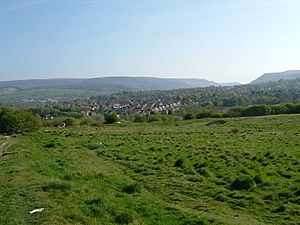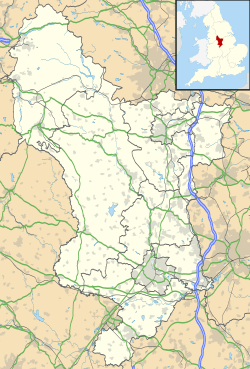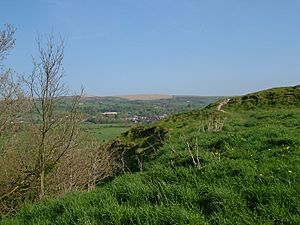Ardotalia facts for kids

The fort today looking towards Longdendale
|
|
| Location | High Peak, Derbyshire |
|---|---|
| Region | East Midlands |
| Coordinates | 53°27′09″N 1°59′17″W / 53.45250°N 1.98806°W |
| Type | Roman fort |
| History | |
| Founded | Cohors Primae Frisiavonum—The First Cohort of Frisiavones |
| Associated with | 3rd Cohort of Bracara Augustani |
| Official name | Melandra Castle Roman fort |
| Reference no. | 1004595 |
Ardotalia (also known as Melandra, or Melandra Castle) is an ancient Roman fort located in Gamesley, near Glossop in Derbyshire, England. This historic site was once a busy military base for the Roman army. It helped them control the area and keep watch over local tribes.
Contents
Building the Roman Fort
Ardotalia fort was built by a Roman army group called the First Cohort of Frisiavones. A "cohort" was a large unit of soldiers, usually around 500 to 1,000 men. This group came from a low-lying area beyond the Rhine river.
We know they built the fort because of special building stones found at the site. These stones had inscriptions or marks from the soldiers. Also, old Roman writings and official documents called "diplomas" mention this unit.
Who Helped Build It?
The First Cohort of Frisiavones got help from another group: the 3rd Cohort of Bracara Augustani. These soldiers likely came from a hilly region in what is now Portugal. They were probably attached to a larger Roman army group called the XX Legion Valeria Victrix, based in Chester.
Who Guarded the Fort?
It's not totally clear which group stayed to guard Ardotalia. However, it's thought that the 3rd Cohort of Bracara Augustani probably manned the fort. Since they were from a hilly area, they were more used to fighting and living in places like the hills around Glossop.
The Frisiavones, being from flat lands, might have been sent to other Roman forts in flatter areas. For example, they might have been stationed in places like Manchester or Northwich.
Other Places the Frisiavones Were Stationed
The First Cohort of Frisiavones also served at a fort called Brocolitia. This fort was part of Hadrian's Wall, a famous wall built across northern England. At Brocolitia, in Carrawburgh, Northumberland, archaeologists found an altar stone. This stone has an inscription that says an officer named Optio Maus repaid a promise to a goddess called Coventina.
What's in a Name?
The name Melandra is a bit of a mystery. It might have been given to the site around 1771 by a man named John Watson. He was a local rector who visited the site when many stone remains were still visible.
The name Ardotalia is thought to come from an old Roman map called the Ravenna Cosmography. On this map, a place called "Zerdotalia" was written, and historians believe it might have been a mistake for Ardotalia.
Ardotalia Today
Ardotalia is a very important historical site. It is protected as a Scheduled Ancient Monument. This means it's a nationally important archaeological site that is legally protected from damage.
However, as of 2020, the fort is on the Heritage at Risk Register. This means its condition is "generally unsatisfactory," with some major local problems. Efforts are likely being made to preserve this important piece of history.
Roman Roads Near Ardotalia
A famous Roman road called Doctor's Gate once connected Ardotalia fort to another Roman fort. This other fort was called Navio fort, located at Brough-on-Noe. Roman roads were very important for moving soldiers and goods across the country.



